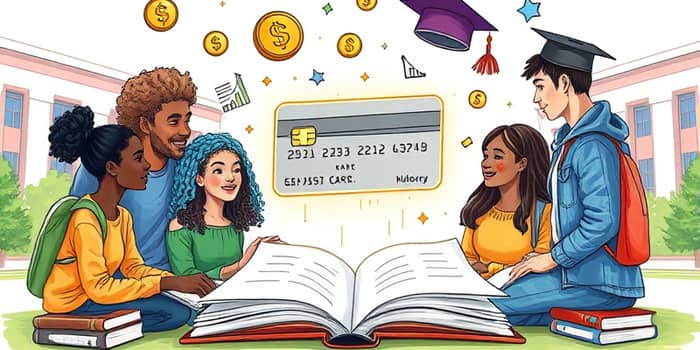As you embark on your collegiate journey, understanding how to manage your finances responsibly can set the stage for lifelong success. One powerful tool in your arsenal is the student credit card — a gateway to building credit, earning rewards, and developing strong money habits.
Understanding Student Credit Cards
Student credit cards are specialized credit products tailored to the needs of college students. They typically come with modest credit limits for beginners and lower eligibility barriers, making them an essential financial tool for newcomers. These cards aim to help you establish a credit history, which is crucial for future financial opportunities.
Designed for those with minimal or no prior credit, student cards often waive annual fees and offer resources to educate users. By using a card responsibly, you can establish credit history early, improving your ability to secure loans, rent apartments, or even land certain jobs that check credit reports.
Eligibility Requirements
Before applying, it’s important to know what issuers look for:
- Age: Applicants must usually be at least 18 years old.
- Enrollment Status: Proof of part-time or full-time enrollment at a two- or four-year institution is required.
- Income: Under-21s need independent income or a co-signer; over-21s can include household income.
- Residency: U.S. citizenship or a valid ITIN for international students.
- Credit History: Many cards accept limited or fair credit, with FICO scores as low as 580 or no credit history at all.
Regulations under the CARD Act of 2009 ensure that students under 21 demonstrate ability to repay, protecting them from unsuitable debt burdens and predatory marketing.
Key Features and Benefits
Student credit cards offer a range of features designed to reward responsible habits and keep fees low:
- Rewards Programs: Cash back of 1–5% on categories like groceries, gas, and dining.
- Introductory APR Offers: 0% APR on purchases for a limited period, helping with larger expenses.
- Educational Tools: Credit-tracking dashboards and tutorials to improve your financial literacy.
- Good Grade Bonuses: Extra rewards for maintaining a certain GPA.
These perks encourage you to spend wisely and understand the cost of credit, while maximize rewards on everyday purchases without incurring extra fees.
Potential Risks and How to Avoid Them
While student cards can be beneficial, they come with potential pitfalls:
High interest rates after promotional periods can lead to debt accumulation if balances aren’t paid in full. Always read the fine print and be aware of standard APRs, which can range from 18% to 27%.
Overusing credit or missing payments can have lasting negative effects on your score. To guard against these dangers, make on-time payments and keep your credit utilization below 30%. Establish a budget that allocates bill payments first, ensuring you avoid high interest pitfalls and maintain financial stability.
Best Practices for Building Strong Credit
Adopting disciplined habits early can pay dividends:
- Pay Balances in Full Each Month: Eliminates interest charges and displays reliability to lenders.
- Monitor Your Credit Regularly: Use free tools provided by issuers or credit bureaus.
- Limit New Applications: Each inquiry can slightly lower your score; space out credit requests.
- Use Rewards Responsibly: Don’t overspend just to chase bonuses.
By following these guidelines, you’ll monitor your credit utilization rate effectively and build a robust credit profile that will serve you well beyond graduation.
Comparing Your Options
When choosing the right student credit card, consider the following comparative factors:
Popular student cards include Discover it® Student Cash Back, Capital One SavorOne Student, and Chase Freedom Student Card. Each offers unique perks; weigh these against your spending habits.
Real-World Impact and Trends
Recent data shows that students who responsibly use a credit card graduate with an average credit score 50 points higher than peers without credit experience. The trend toward no-fee student cards and introductory 0% APR offers helps young adults manage tuition and living costs more effectively.
International students now have more access through ITIN-friendly issuers, expanding financial inclusion. This shift highlights the industry’s recognition of diverse student needs and its commitment to build financial foundations for all.
Conclusion: Empower Your Financial Future
Student credit cards can be a transformative tool when used wisely. They offer an opportunity to build a positive credit history, earn valuable rewards, and develop early financial independence. By understanding eligibility, features, and risks, you can select the card that aligns with your goals and spend responsibly.
Remember, credit is not simply plastic—it’s a reflection of your financial habits. Establish disciplined practices now, and you’ll pave the way for a strong financial future filled with opportunity and confidence.
References
- https://www.bankrate.com/credit-cards/building-credit/pros-cons-of-student-credit-card/
- https://www.equifax.com/personal/education/credit-cards/articles/-/learn/student-credit-cards-what-are-they-how-to-get-one/
- https://www.bankofamerica.com/credit-cards/student-credit-cards/
- https://www.discover.com/credit-cards/card-smarts/student-income-for-credit-card/
- https://www.bankrate.com/credit-cards/building-credit/do-you-have-to-be-a-student-to-get-a-student-credit-card/
- https://www.capitalone.com/learn-grow/money-management/how-to-get-a-student-credit-card/
- https://www.nerdwallet.com/article/credit-cards/student-credit-cards-101
- https://www.chase.com/personal/credit-cards/education/build-credit/student-credit-card-benefits










